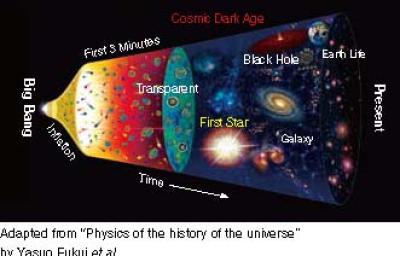
In structure formation of the Universe, our primary interests are in primordial star formation in the early universe, the formation and evolution of galaxies, and the formation of large-scale structure.
The standard Big Bang model posits that the universe was nearly homogeneous and very hot when it was born. Tiny “ripples” in the distribution of matter were generated through a rapid expansion phase called inflation in the very early universe. These primordial density fluctuations grew by gravity, forming first stars, and eventually forming luminous objects such as galaxies.
Since the large scale structure of the Universe can be analytically predicted in linear regime, we can study cosmic acceleration and the energy content of the Universe through the large scale structure. In particular, the measurement using supernovae indicated that the Universe contains mostly unknown energy called “dark energy”. If the Universe is only composed by matter and radiation, the expansion of the Universe has to be decelerated since gravity is an attractive force. Therefore, the discovery of cosmic acceleration implied that the Universe contains some kind of energy which causes this acceleration. There are several ways to study “dark energy” using the large scale structure such as gravitational lensing, baryon acoustic oscillations, and galaxy clusters. The field of observational cosmology is often called “precision cosmology”. This is because galaxy surveys like Sloan Digital Sky Surveys (SDSS) constrain cosmological parameters with great accuracy. Currently, the best constraint reaches 1% accuracy in the measurement of cosmological parameters and ongoing and future galaxy surveys are aiming to achieve a sub-percent level of accuracy.
In Japan, Subaru Hyper Suprime-Cam (HSC) Survey is currently taking the photometric data to constrain cosmology through gravitational lensing and Prime Focus Spectrograph (PFS) will start taking spectroscopic data in 2019 to measure baryon acoustic oscillations. Those galaxy surveys will provide rich information on the nature of dark matter and dark energy as well as neutrino mass.
While galaxies are often used to infer underlying dark matter distribution in large scale structure, formation and evolution of galaxies themselves are exciting research topics. The wide variety of evolutionary paths galaxies take over cosmic time has led to the diverse galaxy population we observe in the present-day universe. The physics of galaxy evolution is complex, involving not only gravity, but also more complex baryonic physics like gas heating and cooling, star formation, and feedback. Kavli IPMU researchers are currently employing a variety of tools to understand this physics and reveal the life history of galaxies.
As a member of the SDSS-IV collaboration, the Kavli IPMU has played a leading role in the MaNGA (Mapping Nearby Galaxies at Apache Point Observatory) survey, an integral field unit survey of 10,000 galaxies in the present-day universe. MaNGA provides continuous spectroscopic measurements over the faces of galaxies, simultaneously revealing their internal motions, star formation activity, chemical composition, and much more. Additional SDSS surveys such as expanded Baryon Oscillation Spectroscopic Survey (eBOSS) and the Legacy survey has allowed researchers to study the behavior of gas around galaxies, probing both infalling gas as well as gas expelled from galaxies by star formation or active galactic nuclei.
The Kavli IPMU is one of the leading members of the HSC survey that is currently obtaining deep, high resolution images of a large region of the sky with the Subaru Telescope. This data set allows us to study the distribution and structural properties of galaxies at multiple epochs. Several Kavli IPMU researchers have also used radio/mm-wave telescopes like the Atacama Large Millimeter Array (ALMA) and Jansky Very Large Array (JVLA) to observe gas, star formation, and active galactic nuclei in the early universe. Finally, several researchers have used computers to both model large galaxy populations and run detailed simulations of individual galaxies. These simulations play a fundamental role in testing and exploring different theoretical models of galaxy formation.
Furthermore, in order to study primordial star and galaxy formation in the early universe, we combine high-resolution spectroscopic observation of the oldest stars in the Milky Way with state-of-the art computer models to derive the nature of the first stars and galaxies. This is the key to better understand the subsequent chemical evolution of the Universe. Results from these studies will be used for improving plans and proposals for Subaru-HSC/PFS dark energy survey. Especially the Prime Focus Spectrograph will provide unprecedentedly high-resolution spectra of metal-poor stars to further deepen our understanding of the early Universe. (Last update: 2018/05/15)
Links
- Related Observational Project: Hyper Supreme-Cam (HSC)
- Related Observational Project: Prime Focus Spectrograph (PFS)
Members
- Shin'ichiro Ando
- Linda Blot
- Robert Brandenberger
- Neal Dalal
- Chenze Dong
- Andrew Eberhardt
- Xiaohui Fan
- Daniela Galarraga Espinosa
- Enrico Garaldi
- Elisa Gouvea Mauricio Ferreira
- Shunsaku Horiuchi
- Benjamin Horowitz
- Miho N. Ishigaki
- Chiaki Kobayashi
- Eiichiro Komatsu
- Kazuya Koyama
- Chervin Laporte
- Khee-Gan Lee
- Kevin McCarthy
- Hironao Miyatake
- Hitoshi Murayama
- Kentaro Nagamine
- Yue Nan
- Nhat Minh Nguyen
- Takahiro Nishimichi
- Ken'ichi Nomoto
- Masamune Oguri
- Masafusa Onoue
- Masami Ouchi
- Sebastien Peirani
- Rahul Ramesh
- Jingjing Shi
- John Silverman
- Aurora Simionescu
- Tomomi Sunayama
- Masahiro Takada
- Naoyuki Tamura
- Atsushi Taruya
- Leander Thiele
- Takafumi Tsukui
- Edwin Turner
- Kiyoto Yabe
- Naoki Yoshida
- Jiaxi Yu






